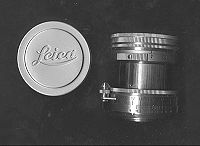Max Berek
Max Berek (born August 16, 1886 in Ratibor (then Upper Silesia) , † October 15, 1949 in Freiburg im Breisgau ) was a German mineralogist and mathematician. He became known for his theoretical considerations and developments in apparatus in the field of polarization microscopy as well as lens constructions for the Leica 35mm camera from the Leitz company in Wetzlar .
Berek came to Leitz in 1912, one year after the designer Oskar Barnack , as a research assistant after he had obtained his doctorate at the Mineralogical Institute in Berlin at the age of 26 with the crystallographer Theodor Liebisch with a thesis on crystal optics .
His most important developments in the field of polarization microscopy, which made Leitz the global market leader in this field, were:
• The "Berek Compensator" for measuring the path differences of birefringent crystals.
• The 4- or 5-axis "universal turntable", a mechanically very complex cardanic rotating device for thin sections for the oriented measurement of optical constants of crystals.
• The "Berek slit photometer" for measuring the reflectivity of opaque materials in vertical incident light.
When Barnack built prototypes of cameras in the 24 × 36 mm format at the beginning of the 1920s, Berek calculated a lens for this that met the special requirements of 35 mm photography. He first created the 50 mm f / 3.5 Elmax lens ( E rnst L eitz Max Berek), a five-lens anastigmat from which the well-known 50 mm Leitz Elmar developed. He also designed the Leitz Summar 1: 2.0 / 50 mm ( 1933 ), the Leitz Hektor 1: 4.5 / 135 mm (1933), the Leitz Hektor 1: 2.5 / 50 mm and the Leitz Summitar 1: 2 , 0/50 mm ( 1939 ).
Berek and his design office were ultimately responsible for the design of a whole range of Leica lenses. The Leica pioneered 35mm photography and continues to set standards today.
Less well-known are his contributions to the psychology of perception , in particular his model of the sighting thresholds of objects, and its connection with the performance data of long- range optical instruments, which led to a new definition of telescope performance .
Max Berek was appointed honorary professor at the University of Marburg in 1924 , where he taught until shortly before his death.
literature
- Siegfried Rösch: Berek, Max. In: New German Biography (NDB). Volume 2, Duncker & Humblot, Berlin 1955, ISBN 3-428-00183-4 , p. 67 ( digitized version ).
- Literature by and about Max Berek in the catalog of the German National Library
Individual evidence
- ↑ M. Berek: On the basic physiological law of the perception of light stimuli. In: Zeitschrift für Instrumentenkunde. Volume 63, 1943, pp. 297-309.
- ↑ M. Berek: The useful power of binocular earth telescopes. In: Journal of Physics. Volume 125, No. 7-10, 1949, pp. 657-678.
Web links
- Large polarizing microscope from Leitz from 1929 with the Berek compensator and the UT4 universal turntable from Berek in use
| personal data | |
|---|---|
| SURNAME | Berek, Max |
| BRIEF DESCRIPTION | German mineralogist and optician |
| DATE OF BIRTH | August 16, 1886 |
| PLACE OF BIRTH | Racibórz |
| DATE OF DEATH | October 15, 1949 |
| Place of death | Freiburg in Breisgau |



